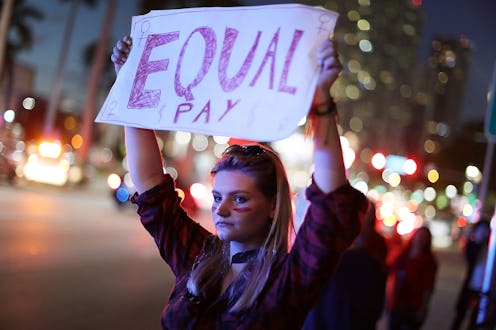News
Here's How Sexual Harassment Could Make The Gender Pay Gap Even Worse

It's been more than 50 years since President John F. Kennedy signed the Equal Pay Act (EPA), yet women continue to make less than their male counterparts. But why? While differences in education and occupations don't explain why the gender pay gap continues to persist, research shows there may be a link between the gender wage gap and sexual harassment.
While the gender pay gap might differ by year and location, it is still very, very real. A 2017 American Association of University Women (AAUW) study found that in 2015, women were paid 80 percent of what men were, on average. And while the gender pay gap is all too often discussed as one number, the truth is, women of color experience a wage gap significantly larger than 80 cents. In fact, recent numbers show black women are paid on average 63 cents for every dollar non-Hispanic white men earn, while Latinas receive 54 cents.
In light of 2017's #MeToo movement and revelations about the prevalence of sexual harassment in the workplace, it is important to examine how sexual harassment affects the gender wage gap. Thankfully, number of researchers have done just that.
In a study first published in May of 2017, researchers found "sexual harassment increases financial stress, largely by precipitating job change, and can significantly alter women's career attainment." Specifically, the study found that women who reported having been sexually harassed at work were 6.5 times more likely to change jobs compared to women who had not been harassed. And often the change wasn't into a job with a higher salary or more growth potential.
Rather, researchers found some of the women they interviewed were actually knocked "off-course during the formative early years of their career" as they took lower paying jobs or moved into less lucrative industries in an attempt to extract themselves from a job where they'd been sexually harassed. The negative effects that can accompany such a job change were often found to follow women throughout the rest of their careers, impacting them in the long term.
"The effect of sexual harassment was comparable to the strain caused by other negative life events, such as a serious injury or illness, incarceration, or assault," those researchers noted. "About 35 percent of this effect could be attributed to the job change that occurred after harassment."
But the link between sexual harassment and the gender pay gap may be more complicated than it first looks. According to research done by Vanderbilt University law and economics professor Joni Hersch in 2011, women who continue to work in occupations or industries where sexual harassment is commonly reported typically earn more than those who move into so-called lower-risk fields.
"Women employed in jobs with an average probability of sexual harassment are paid a compensating differential of 25 cents per hour relative to comparable women employed in jobs with no risk of sexual harassment," Hersch reported in an analysis of her research. But women weren't the only ones receiving more pay. Hersch found men employed in jobs found the be high-risk for sexual harassment made an additional 50 cents an hour compared to men working in jobs with no risk. Hersch compared this extra bit of pay to how workers employed in industries or occupations associated with high risk of injuries or fatality receive hazard pay.
For now, research into the potential links between sexual harassment and the gender pay gap is relatively new, meaning more analysis is needed to fully understand what the impact is. But as the national conversation about the pervasiveness of sexual harassment continues to unfold, hopefully so too will the research.